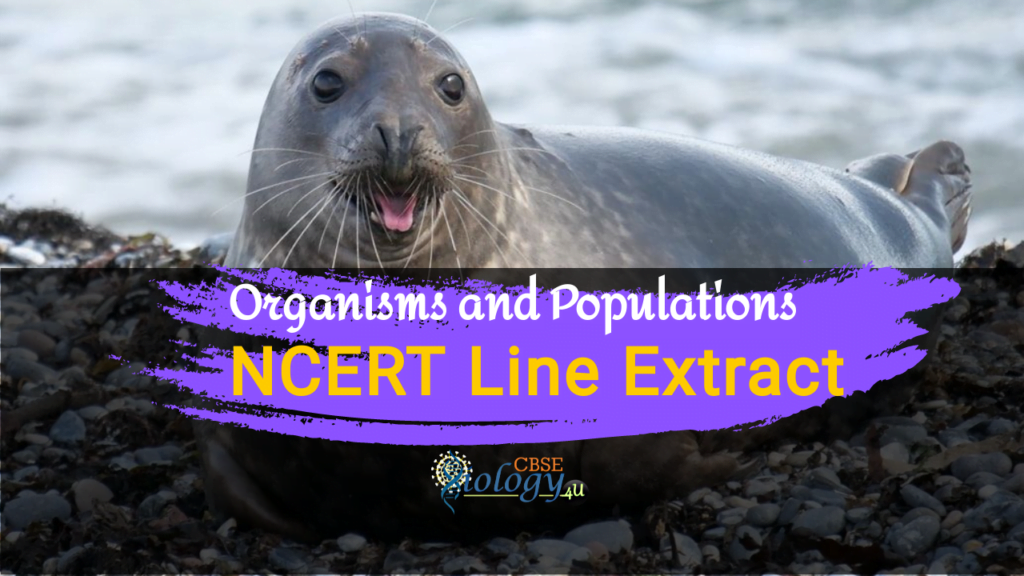1. Comment on the mean annual precipitation and the mean annual temperature of the alpine and arctic tundra biome.
2. A biome is having a mean annual precipitation ranging from 150 cm -400 cm and mean annual temperature of 20-250C. identify the biome.
3. Define biome. How is it different from a population?
4. State the two factors that affect the formation of a biome.
5. What do you understand by stenothermal and eurythermal organisms? Provide examples for each of these. Do these two categories of organisms live in the same geographical area? Justify your answer.
6. How do you represent the measure of the salt concentration in a water sample?
7. What is the concentration of salt in water in:
a. Hypersaline lagoon
b. Fresh water
8. What are euryhaline organisms? State one example.
9. Many fresh water animals cannot live for long in the sea water. Explain why?
10. What is the adaptation exhibited by small plants for photosynthesis, that are overshadowed by canopy of tall trees?
11. What activities in animals are affected by light intensity and duration?
12. Organisms living in the deep ocean (>500m) live in an environment which is in a perpetually dark condition. How do they obtain their energy?
13. The percolation and water holding capacity of soil is determined by what factors?
14. In an aquatic environment what determines the type of benthic animals that can thrive there?
15. Define homeostasis.
16. What are the two processes by which regulators maintain homeostasis?
17. Why are very small animals rarely found in polar regions?
18. An organism responds to change in ambient temperature either by increasing or decreasing its body temperature. Can you tell what category of organism will this fall into with respect to homeostasis.
19. Why do birds migrate?
20. Define the following terms and provide one example for each.
a. Hibernation
b. Aestivation
c. Diapause
21. What are the features of dormancy state of seeds of higher plants with respect to suspend condition?
22. What are the physiological adaptations in desert plants to minimize water loss?
23. State the importance of blubber present in seals.
24. How does Kangaroo rat survive its entire life without drinking water?
25. State Allen’s rule.
26. State two adaptation in humans at high altitude to prevent altitude sickness.
27. State morphological adaptations seen in desert plants.
28. Name an organism that exhibits behavioral adaptation to maintain temperature homeostasis.
29. Mention the four attributes of a population that is not found in individual organisms.
30. What is an age pyramid of human population? Under what condition will it be declining?
31. Define population density. How can we calculate population density for fish and tiger?
32. State the process that fluctuates the population density. Explain each of them.
33. Provide the equation that will help us to calculate population density at any point of time.
34. Of the two growth models which one is more realistic and why?
35. What are the two factors that are essential for exponential growth model?
36. Define carrying capacity.
37. How can you represent logistics growth curve through equation?
38. In a population interaction one of the species neither loses nor gains while the other species loses. Identify this interaction.
39. Differentiate between predation and parasitism as in both of these interactions one of the species gains and other the other species loses.
40. State any three roles of predators in a population.
41. State any five adaptation that are developed by prey for protection against predators.
42. Why did more than 10 species of invertebrates become extinct within a year from an enclosed intertidal area when all the starfish were removed.
43. In Australia, the Prickly pear cactus caused havoc by spreading across millions of hectors of rangeland. How was it brought under control?
44. Mention any four adaptation of parasites that has developed over time to survive in the host body.
45. Cuckoo and Crow exhibit a unique population interaction. Name it and explain it.
46. Explain competitive release with the help of an example.
47. What do you understand by Gause’s competitive exclusion?
48. What is commensalism? Provide four examples.
49. How does Lichens and Mycorrhizae benefit by mutualism?
50. Why is it important for Ophyrs and male bee to co-evolve?
51. Why does the fig tree gets pollinated only by a specific wasp species? Explain in details.
52. How can two species competing for the same resource avoid competition?

